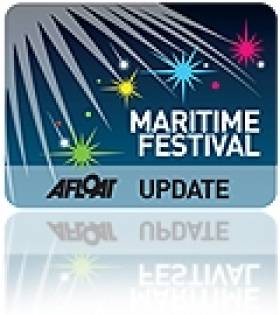Displaying items by tag: Clew Bay
"Significant" Late Bronze Age Fort Identified in Clew Bay
Archaeologists have discovered a prehistoric fort in Clew Bay which has been described as “very significant”.
As The Irish Independent reports, the fort has been identified on Collanmore island, Co Mayo, which was once one of the Glenans Franco-Irish sail training school bases.
Archaeologist Michael Gibbons says that initial surveys suggest the island was used for a fort dating from the late Bronze Age, and it is comparable to Inis Mór’s Dun Aengus.
Several large ramparts across the tidal isthmus linking the island to the shoreline are believed to have been constructed as part of the fort.
The set of double ramparts are “most likely to be late Bronze Age in date, dating between 1100-900 BC”, Gibbons says, and had ben covered in seaweed..
The outer rampart was known to local residents, but they didn’t realise its significance, he says.
The scale of the double ramparts indicates the island was of major strategic importance, and similar ramparts can be seen at other coastal and lake promontory forts on the west coast, he says.
Nearest examples can be found on Lough Fee, north of Newport,Co Mayo, where there is a large lake promontory fort, and a large promontory fort on Lake Carra, Gibbons says.
The late Bronze Age hillforts are the largest monuments built in Ireland, linked to “warlord dominated societies”, he says.
The Clew Bay discovery has been reported to the National Monuments Service.
A possible “burial cist” or stone-lined grave on the coastline opposite north Connemara’s Omey island has also been reported, after it was found by Carmel Hannon-Madden on the beach at Fountain Hill townland.
The cist is made up of an arc of six stones opening to the west, but its location is exposed to swells.
Read The Irish Independent here
Buoy-Oh-Buoy: Red Alert For Missing Mooring
Alex Blackwell, the noted voyager of Clew Bay, has a thing about moorings and anchoring. In fact, he and his wife Daria, in between intervals of oceanic cruising and making a direct administrative input with both the Ocean Cruising Club and the Irish Cruising Club, somehow found the time to write the definitive and highly-regarded book, “Happy Hooking –The Art of Anchoring”.
Published by their company White Seahorse, it takes its philosophy from revered western old salt Tommy Moran: “Anchor as though you plan to stay for weeks, even if you intend to leave in an hour”. Thus, those of us who have anchored with care and consideration for others, only to be subsequently verbally abused with “You anchored too close (expletives deleted” by people whose boat has dragged down on top of us from a very considerable distance, can always take comfort and information from the sage Blackwell words. And when Alex draws attention to something of significance, everyone takes notice, particularly those of us who prefer to use our own anchor, but sometimes find there’s no alternative to using the visitors moorings when they fill an anchorage.
 Alex & Daria Blackwell – their pleasure in freely voyaging is matched by a determination to stay put when anchored.
Alex & Daria Blackwell – their pleasure in freely voyaging is matched by a determination to stay put when anchored.
 The distillation of years of experience in successful cruising - the definitive sourcebook of sound anchoring
The distillation of years of experience in successful cruising - the definitive sourcebook of sound anchoring
His latest online posting is a classic, and deeply concerning. On a Clew Bay beach, he found the drifted buoy of a Visitors’ Mooring. While the visible bits above water were reasonably well maintained, it was painfully obvious that the main chain – the riser – hadn’t been seriously inspected in years, having rusted away to such a curious extent that it might almost be a piece of modern mini-sculpture.
Maybe so, but in its final functioning days, it couldn’t have held a boat of 15 milligrams, let alone the proclaimed 15 tonnes. Being very much a Mayo man, Alex was relieved to find that none of the local installations of visitors’ moorings had the originally yellow plastic buoys painted red. That was done in this case, though one would guess it was a paint job a very long time ago. Whatever, if you happen to know of an anchorage where somebody has gone to the trouble of painting the visitors’ mooring red, but has evidently failed on the follow-up maintenance, do please let us know, as visitors’ moorings have been a feature of many Irish anchorages for some time now, and it would be alarming to think this is not an isolated case.
 Much of the Blackwells’ extensive cruising has been done in the Bowman 57 Aleria, whose excellent sailing performance has been matched by the owners’ determination to be completely secure when stopped, regardless of the amount of time they plan to be anchored
Much of the Blackwells’ extensive cruising has been done in the Bowman 57 Aleria, whose excellent sailing performance has been matched by the owners’ determination to be completely secure when stopped, regardless of the amount of time they plan to be anchored
Atlantic Coast’s Clew Bay Has New Speciality Coffee Range Funding Marine Restoration
Clew Bay on the Mayo coast is in a league of its own. Outstandingly beautiful, with the serene peak of Croagh Patrick rising above Ireland’s most intricate and dynamic inter-mingling of sea and islands through many inlets large and small, the Bay has long fostered a vibrant maritime community that pre-dates its most illustrious star, the 16th Century sea queen Granuaille.
In current times, ocean voyagers such as James Cahill and Arctic Ocean circumnavigation pioneer Jarlath Cunnane have set forth from here, and most recently the long-distance mantle has maintained by Alex and Dara Blackwell. Offshore racing, meanwhile, has seen Clew Bay up in lights thanks to the efforts of Joan Mulloy and also of Louis Mulloy, noted campaigner of the J/24 Headcase and the MiniTransat Black Shell Farm.
SUSTAINABLE SEAFOOD PRODUCTION
In many cases, the maritime involvement of these enthusiasts extends far beyond waterborne sport and recreation, for as a very environmentally-aware group, they are acutely attuned to the way that a carefully monitored seabed is beneficial in all its aspects, and especially in providing a sustainable seafood industry within the Bay’s many inlets and island passages.
Michael Mulloy, the patriarch of a remarkable nautical clan, has led the way in developing a matrix of productive industries which are scaled to respect their surroundings, supported by multi-tasker Alex Blackwell in his capacity as a Fisheries Biologist. Usually, they quietly get in with their jobs and often only attract attention for other activities such as Alex’s key roles in the administration of Irish cruising. But now a novel coffee marketing initiative has drawn the focus towards the sheer variety of what they do.
 Northabout returns to Clew Bay after her Arctic Ocean circumnavigation with Jarlath Cunnane and Paddy Barry. Photo: Rory Casey
Northabout returns to Clew Bay after her Arctic Ocean circumnavigation with Jarlath Cunnane and Paddy Barry. Photo: Rory Casey
COFFEE AND OYSTERS COMBINE
Green Ocean Coffee, a new speciality coffee range from Irish company Watermark Coffee, has been officially launched to coincide with a unique partnership agreement with Clew Bay Oyster Co-op.
Expertly roasted in Ireland, Green Ocean Coffee is made from 100% speciality grade arabica beans sourced directly from farmers in Brazil, Kenya and Honduras. Available in fully recyclable packaging, the three coffee blends deliver a vibrant, modern flavour and are named ‘Inishgowla’, ‘Dorinish’ and ‘Inisheeny’ after islands in Clew Bay.
Recognising the importance of the ocean’s potential role in tackling and reversing the effects of climate change and improving coastal biodiversity, Watermark Coffee’s partnership with Clew Bay Oyster Co-op aims to restore up to 180 hectares of seabed in Clew Bay, Co. Mayo from sales of Green Ocean Coffee.
For every 1kg bag of Green Ocean Coffee sold, one square metre of the oyster and seagrass bed will be restored, helping to lock away oceanic and atmospheric carbon at rate up to 35 times faster than the tropical rainforest.
CHANGES IN OCEAN HABITAT
David Lawlor, Managing Director of Watermark Coffee and himself a sailor of Wayfarer dinghies from the National Yacht Club in Dun Laoghaire, explains the motivation behind this novel project:
“At Watermark Coffee, we are committed to producing exceptional coffee whilst running our business in a way that minimises our environmental impact. As a sailor and diver myself, I have witnessed significant change to the ocean habitat, and have a deep appreciation of the vital role the ocean plays in stablising our global climate. As a company, we want to play our part, and give our customers the opportunity, to protect the biodiversity of our ocean in the long term. Green Ocean Coffee is about providing the conduit that links drinking amazing coffee with authentic climate action right here in Ireland”.
 Alex Blackwell of Clew Bay Oyster Co-op and David Lawlor of Watermark Coffee on the shores of Clew Bay with their respective products
Alex Blackwell of Clew Bay Oyster Co-op and David Lawlor of Watermark Coffee on the shores of Clew Bay with their respective products
As an island nation, the role the ocean and in particular, oysters and seagrass, play in protecting our marine environment cannot be underestimated as Alex Blackwell, Fisheries Biologist and Manager of Clew Bay Oyster Co-op explains;
“Balance is key to a healthy ocean. Oyster and seagrass beds are a pivotal component in sequestering atmospheric carbon dioxide as well as providing coastal protection and creating sustainable employment. Oysters are nature’s most efficient filtration system, filtering up to 190 litres of seawater a day. They keep algae blooms at bay and encourage the growth of seagrass - one of the planet’s most overlooked sequestering plants. It’s a dream come true to have Green Ocean Coffee on board so we can continue to do this important restorative work”.
OCEAN COFFEE MATCHES AIMS OF WOODLAND COFFEE ASHORE
The launch of Green Ocean Coffee joins Watermark Coffee’s wider sustainable range, Woodland Coffee, which saw the company investing in a dedicated woodland plantation in Pallasgreen, Co. Limerick in 2020. To date, 27,000 trees have been planted as a result of Woodland Coffee sales. Watermark also participates in the rigorous Carbon Disclosure Project, a not-for-profit charity that runs the global disclosure system for investors, companies, cities, states and regions to manage their environmental impacts.
 They’ll clean the sea or brighten you up….oysters and coffee make for a dynamic combination
They’ll clean the sea or brighten you up….oysters and coffee make for a dynamic combination
Green Ocean Coffee is available wholesale to changemaker companies who share Watermark’s passion for driving sustainability, right down to the coffee they provide to their employees in the workplace. Watermark provide on site barista training, tastings, coffee machines and servicing. The range is also available to consumers to purchase on-line via www.greenoceancoffee.ie and retails at €15 for a 500g bag and €25 for a 1kg bag.
David Lawlor added: “We are very excited to launch Green Ocean Coffee after three extensive years of research and planning. We have had tremendous help and advice at all stages from diving experts in Ocean Divers, to Bord Iascaigh Mhara and of course Alex Blackwell and Michael Mulloy of Clew Bay Oyster Co-Op. Their enthusiasm and knowledge have helped make Green Ocean Coffee a reality. We are looking forward to working with new corporate clients and consumers to deliver great coffee and make a meaningful difference to the ocean that surrounds us.”
Michael Mulloy, Chair of Clew Bay Oyster Co-op concluded; “Native oysters in a bay is like the canary in a cage to a certain extent. If you have an abundance of native oysters in a fishery, it is an indication that your biodiversity is good. We are privileged to have retained native oyster beds in Clew Bay, and we are looking forward to working with our partners in Green Ocean Coffee to ensure these beds are protected into the future”.
Ocean Cruising Club’s “Get-You-Home” Nerve Centre on Clew Bay Recalls Club’s Irish Links
At Port Aleria on Clew Bay in Mayo, Alex and Daria Blackwell can see their Bowman 57 ketch Aleria when she’s on her moorings off their house. But at the moment, their minds are often elsewhere, as Daria is Vice Commodore of the Ocean Cruising Club, whose many voyaging members worldwide have sometimes been finding themselves on the wrong side of local Covid-19 Lockdowns.
Helping them to plot a route home, or at least to a more friendly environment, has been entrusted to the Vice Commodore and her husband-shipmate. Thus Port Aleria has become a nerve-centre for passage planning and monitoring for a wide variety of craft from many nationalities in a large number of locations. And one of them has been Danu, the Kinvara-based 39ft steel ketch which is currently on a Transatlantic circuit cruise with Vera Quinlan, her husband Peter Owens, and their two children Lillian (12) and Ruari (10).
Their dream cruise was beginning to take on several aspects of a nightmare, as some of the Caribbean islands imposed local hyper-strict lockdowns. But the crew of Danu are a notably resourceful and good-humoured foursome, and even in situations which others might have found maddeningly frustrating, they managed to make the best of it to add to their rich store of experiences. Eventually, they found their way to Antigua, which was one of the assembly points for a flotilla of OCC boats due to leave for Europe at much the same time from several islands.
There was further frustration with a lack of wind for some days, and with the need to conserve fuel and use sail as much as possible over what might be a 4,000 mile voyage - though with the possibility of a pit stop at the Azores – patience was need until the breeze filled in. When it did, they finally got away on Saturday in company with Peter Whatley’s La Boheme. Their patience is rewarded, as Danu is currently making good progress under sail in the right direction three days after departure.
Meanwhile, ocean voyagers everywhere are either trying to do the same thing, or are watching to keep an eye on how others are doing, and a couple from Northern Ireland, Kevin & Susie Harris with the 1993 Jeanneau Sun Odyssey 47 Temptress of Down (originally Laragh based at Crosshaven), have been negotiating tricky waters as they draw towards the final stages of their global circumnavigation, which started in 2013.
 The much-travelled Sun Odyssey 47 Temptress of Down was Crosshaven-based when new in 1993.
The much-travelled Sun Odyssey 47 Temptress of Down was Crosshaven-based when new in 1993.
“Final stages” is a very relative term when you’re cruising round the world, for in the case for Temptress and her crew, it has involved how best to get from Sri Lanka into European waters. The situation in the Middle East is so volatile that the Ocean Cruising Club are reluctant to advise going there, but the prospect of the long haul down round South Africa seemed equally unappealing, so Kevin and Susie kept with their plan of simply going for it through the notoriously windy Red Sea and the Suez Canal.
From time to time, yacht convoys get formed to transit these potentially hazardous areas in the hope of finding safety in numbers. But like circumnavigators Pat and Oliva Murphy of Howth with Aldebaran in 2007, the Harrises found themselves on their own, and just went for it despite the added problems of the spread of Covid-19.
Fortune favoured the brave, and they were through the Suez Canal and into the Mediterranean by May 2nd. After replenishing stores and resting up in Crete, where they were provided with generous supplies of welcome fresh produce by the neighbourhood farmers, Temptress and her crew are now in mainland Greece at Missolonghi (yes, Byron’s Missolonghi) with the country and its minimal Coronavirus infection rate rapidly emerging from lockdown.
Meanwhile, the Ocean Cruising Club’s support network is a reminder that the club was founded in 1954 by Humphrey Barton (1900-1980), who was very active in the Irish Cruising Club when he was working in Belfast as a consulting engineer in the 1930s. He continued to maintain these ICC links, and today the OCC has a significant Irish membership, with the Vice Commodore Daria Blackwell based in Clew Bay, while the OCC Roving Rear Commodore (Baltic) is Andrew Curtain of the Royal Irish YC in Dun Laoghaire.
The OCC Atlantic Fleet are in this Wind Prediction Tracker here
Why Shouldn't The Irish Be A Seafaring People?
We may be an island nation, but are we a maritime people in our outlook and way of life? It could be reasonably argued that we most definitely aren’t. On last night’s Seascapes, the maritime programme on RTE Radio 1, Afloat.ie’s W M Nixon put forward a theory as to why this should be so. It’s based on a premise so simple that you’d be very confident somebody else must have pointed it out a long time ago. Yet despite Nixon’s notion being in the realms of the bleeding obvious, even with the aid of Google we cannot find any other commentator or historian making a straightforward suggestion along these lines, but will gladly welcome proof to the contrary.
Why aren’t we Irish one of the world’s great seafaring people? After all, we live on one of the most clearly defined islands on the planet. And it’s an island which is strategically located on international sea trading routes, set in the midst of a potentially fish-rich sea. Our coastline, meanwhile, is well blessed with natural havens, many of which are in turn conveniently connected to our hinterland by fine rivers which, in any truly boat-minded society, would naturally form an integrated national waterborne transport system.
Yet the traditional perception of us is as farmers, cattle traders and horse breeders of world standard, while the more modern view would include our growing expertise in information technology and an undoubted talent for high-powered activity in the international aviation industry. Then too, there is our long-established standing in the world of letters and communication and the media generally. Yet although there are now encouraging signs of a healthier attitude towards seafaring and maritime matters, particularly in the Cork region, for most Irish people the thought of a career in the global seafaring and marine industry simply doesn’t come up for consideration at all.
So why is this the case? I think the basic answer could not be simpler. The fact is, nobody ever walked to Ireland. The prehistoric land-bridges to Britain had disappeared before any human habitation occurred here. Our earliest settlers could only have arrived by primitive boat, and that was only ten thousand or so years ago. But even then, boats were still so basic that the often horrific seafaring experiences would have generated the pious hope of having absolutely nothing further to do with the sea and seafaring for the passengers, once they’d got safely ashore. And that attitude was handed down from one generation to the next.
While the south of England, with its land-bridge still connected to continental Europe, had experienced quite advanced human habitations for maybe as long as 400,000 years, Ireland by contrast was one of the very last places in the temperate zones to be taken over by human settlement, and those first settlers must have come by boat of some sort.
So even in terms of the relatively brief period of human existence on Earth, the settlement of Ireland is only the blink of an eye. Thus in talking of “Old Ireland”, we’re talking nonsense. Ireland is a very new place in terms of its human history. Yet although we’ve only been here ten thousand years, all the archaeological research points to the relatively rapid development of a complex society with some very impressive monuments being built in a relatively short period, and by a society which had become highly organised and technologically advanced within a compact timespan.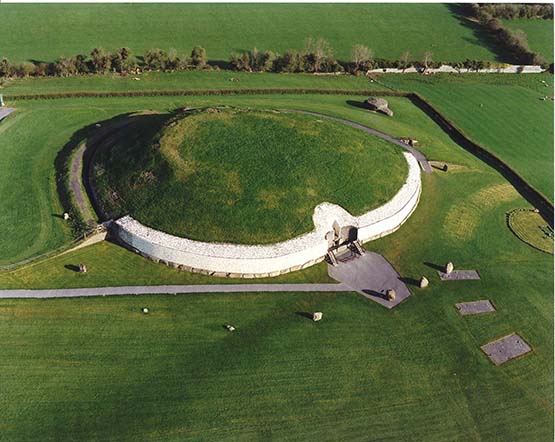 Newgrange in County Meath - 5000 years old, and eloquent evidence of the sophistication of Ireland of the time
Newgrange in County Meath - 5000 years old, and eloquent evidence of the sophistication of Ireland of the time
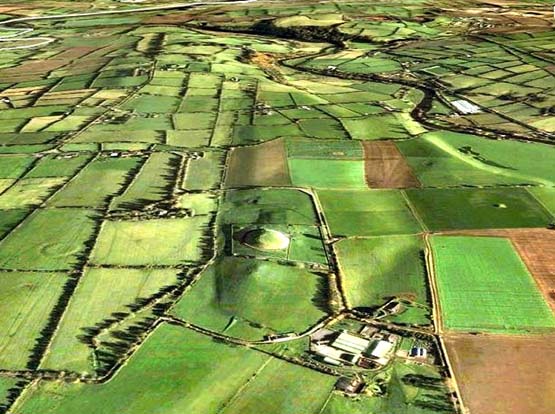
Newgrange’s location close to the River Boyne (top right) is a reminder that while basic river transport had become quite highly developed, in this era Irish seafaring was still in its earliest and most primitive stages despite the people’s ability to undertake the advanced calculations used in the construction of Newgrange.
So these were not a people who were just passing through. The earliest Irish were determined to make something special of their new home with some colossal and impressive sacred buildings and structures. To some extent this reflected the possibility that they were totally committed to creating a meaningful life in Ireland perhaps because they saw themselves as now marooned on it.
This sense of being marooned would have become embedded and emphasised in the compact family and tribal groups which very slowly spread across the island as a basic farming and hunting people. The inherited memories of the horror of the voyage to attempt to reach Ireland, in which many lives must have been lost at sea, would have been passed down from generation to generation, and we can be sure that the potential hazards of such an enterprise would lose nothing in the re-telling and embellishment of the ancient stories around the family hearth.
In other words, the longer your people have been in Ireland, then the greater would be your inherited sense of the risk in seafaring. Put another way, you could say that the very earliest Irish were not a seafaring people because the very earliest Irish mammies were absolutely determined that their sons were not going to seek a living on the dreadful sea. In the way of Irish mammies, they made sure that everyone knew this, and they have continued to do so to the present day.
If this emphasis on the adverse effect of inherited unhappy memories seems to over-state the case, consider the circumstances of the ancient people of the Canary Islands. When the Spanish voyagers first discovered the Canaries at a time not so very distant from Columbus’s voyages to America, they thought initially that the islands were uninhabited. It was only later that it was discovered that the highest mountain regions were home to an isolated people who were distantly related to the Berbers of North Africa.
In the remote past, these mountain people’s ancestors had somehow – possibly unintentionally – made the 62 mile voyage across from Africa. It is only eight miles further than the shortest distance between Wales and Ireland. But the seas are significantly warmer, which you’d expect to be a favourable circumstance for encouraging further voyaging. Yet having finally struggled ashore, those first Canary Islanders were very soon distancing themselves from the sea and seafaring.
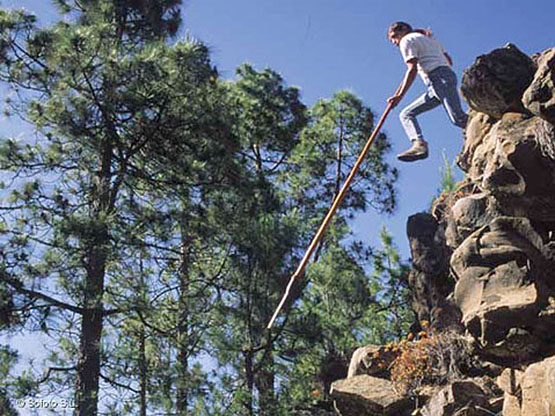 The Shepherd’s Leap (Salto del Pastor) of the Canary Islands. The earliest islanders in the Canaries turned their backs on boats and the sea so completely that they retreated away from the coasts and went to live in the mountains. There, they developed a unique way of life including this primitive pole-vaulting – now a traditional sport – in order to descend cliffs or traverse ravines
The Shepherd’s Leap (Salto del Pastor) of the Canary Islands. The earliest islanders in the Canaries turned their backs on boats and the sea so completely that they retreated away from the coasts and went to live in the mountains. There, they developed a unique way of life including this primitive pole-vaulting – now a traditional sport – in order to descend cliffs or traverse ravines
Any small enthusiasm they might have had for boats soon disappeared completely, such that they now have no shared knowledge or memory of boats at all. And up in the mountains, their most remarkable talent is the ability to pole vault down into or across the ravines – the Shepherd’s Leap - in order to travel about in their vertiginous homeland, which was seen as preferable in every way to the real dangers of seafaring.
In a Thomas Davis lecture for Seascapes a dozen or so years ago, I discussed the specialised nature of those whose primary interest in the early days of Irish settlement lay in seeing seafaring as a viable way of life. So relatively rare were such people that I reckoned at the time that this talent for exploiting the diverse wealth which the sea offered would provide them with useful survival mechanism for themselves and future generations of their families.
But I now realise that I got it totally wrong. Absolutely the opposite must have been the case. Once you and your people had got safely to Ireland in the first wave of settlers, the seafaring was still so basic and consistently dangerous that having nothing further to do with it was a much better way of ensuring the continuing survival of your genetic stock, whereas producing a family of would-be sailors could see the end of the line in a very short few years.
Although the popular view in Ireland is that our earliest ancestors must have sailed direct from Iberia, it seems to me that Western European seafaring would have been so primitive in those days ten thousand years ago that the first settlers must have voyaged across in nondescript vessels from the most easily reached part of the nearby British land, which is the large island of Islay off southwest Scotland.
As it happens, DNA testing on the current population of southwest Scotland indicates that they too have significant elements of our Iberian stock. Thus there is a shared gene pool, and the earliest Irish most likely came by the easiest route from Scotland, whose people in turn had travelled overland from Europe via England.
If that seems a bit hard to take for those of us who like to think that we’re essentially a Mediterranean people left out in the rain, that we’re essentially a formerly seafaring race who came directly by sea from our ancestral homelands in the Basque region, be consoled by the fact that many centuries later Scotland itself was to undergo conquest by invaders from Ireland of the Scoti tribe, who gave a new name to a country formerly dominated by the Picts.
However, that was very much later, when seafaring technology had greatly advanced, and people could regularly sail across the waters between Ireland and Scotland with some confidence. But when the earliest land-starved pioneers were contemplating crossing to Ireland from Scotland, they would have first looked for the shortest route. The absolute shortest distances between Scotland and northeast Ireland is in the North Channel between the Mull of Kintyre and Fair Head in County Antrim. There, the straight line distance is barely a dozen miles, yet you are facing one of the most tide-riven, roughest and coldest sea channels in Europe. And should you make it safely across, the landing at the nearest point on either side is decidedly difficult.
Further south, the shortest distance between the Mull of Galloway in southwest Scotland across the North Channel to northeast County Down is only 20 miles, but here again in early times the landings were inhospitable on either side, and the tides could be ferocious in their adverse impact.
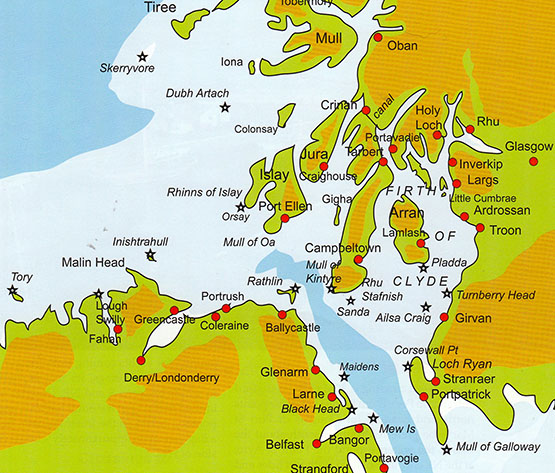
The crossings between Scotland and northeast Ireland which would have been faced by the earliest settlers. While the shortest distance between Kintyre and Fair Head to the east of Ballycastle is just over 12 miles, and the distance between Portpatrick and the nearest part of County Down is barely twenty miles, the entire North Channel between Rathlin Island and the Mull of Galloway is tide-riven, notoriously rough, and with the coldest sea temperatures on the Irish Coast. The earliest voyagers in very primtive boats would thus have had a better chance of a safe crossing, with more options as to their ultimate landfall, by setting off from Port Ellen in Islay, and having avoided the notorious tide race to the southwest of the Mull of Oa, then shaped their course to wherever the winds suited to make a landfall between Inishtrahull and Rathlin. The oldest human settlement in Ireland is at Mount Sandel near Coleraine. Plan courtesy Irish Cruising Club
But if you approached the Scotland-Ireland passage from the mainland of Scotland to the northeast, gradually working your way southwestwards through the southern Hebrides and gaining some seafaring experience with short inter-island hops until you were strategically placed at the natural harbour of what is now Port Ellen on the south shore of Islay, then the prospects were better. You might have still been all of 25 miles from Ireland, but it was a more manageable crossing. You had much greater choice in your possible destinations in making an Irish landfall, as you’d the entire Irish coast from Fair Head to Malin Head to aim for.
In reasonable weather, you could see where you were going, and with prevailing westerly winds there’d be a good chance it would be a relatively easy beam reach if you happened to have a primitive sailing rig, though the likelihood is the early boats were paddled, or rowed in primitive style.
Whatever the method of propulsion, there’s no disputing that one of the oldest sites of human habitation in Ireland is right in the middle of this northern coastline, at Mount Sandel on the River Bann in Coleraine. Yet no matter how much research and archaeology has been undertaken at Mount Sandel and at other ancient sites, no evidence of significant Irish human settlement has been found which goes back any further than ten thousand years.
As it happens, it was ten thousand years ago that mankind first developed the genetic mutation that enabled our ancestors to digest dairy products. But another five thousand years were to elapse before the first cattle were brought to Ireland to find that the place might have been invented for them, and cattle became a source and a measure of wealth. This new socioeconomic development pushed the sea and any form of seafaring even further down the social scale as a viable career option. Who would think of being a fulltime sea fisherman in a land noted as flowing in milk and honey? And even though water transport using rivers became a significant part of Irish life – notably in Fermanagh where the Maguires were to have a water-based mini-Kingdom - the sea was still viewed with suspicion, while the consumption of fish – whether from salt water or fresh – was regarded as socially inferior to eating meat.
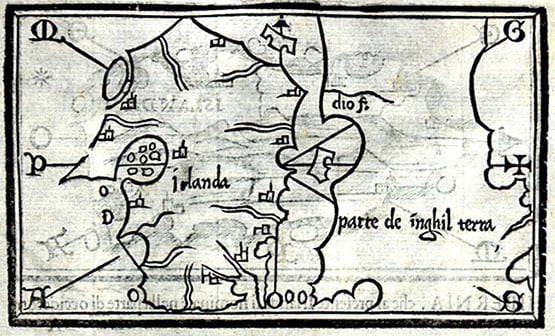
Mediaeval map of Ireland. It’s just possible that the island-studded inlet shown on the west coast is the Maguire-ruled Lough Erne, but more likely it is Clew Bay given prominence through Grace O’Malley.
It was only with improvements in seafaring technology and the general seaworthiness of ships that later generations and new groups of settlers might have brought a more positive attitude towards the sea. Then there was a period of about 1200 years – rudely ended by the first arrival of the Vikings around 795AD – when Ireland was remarkably free of invasions, yet enough marine technology had developed in the island for a brief flowering of Irish seafaring with the extraordinary voyaging of the Irish monks.
It has been argued by some scholars that there was no such person as St Brendan the Navigator. But undoubtedly there were great seafaring monks, and those of us who say that if it wasn’t St Brendan then it was somebody else of the same name will occasionally make the pilgrimage across from Dingle to rugged little Brendan Creek close under the west slopes of Mount Brandon on the north shore of the Dingle Peninsula, and wonder again at those Irish men of limitless faith setting out from this sacred spot into the great unknown in light but able boats.
But as it was seaborne asceticism which they sought rather than wealth, it was seen as a highly specialized and rather odd interest when most of the people were much more readily drawn to epic tales of profitable cattle raiding.
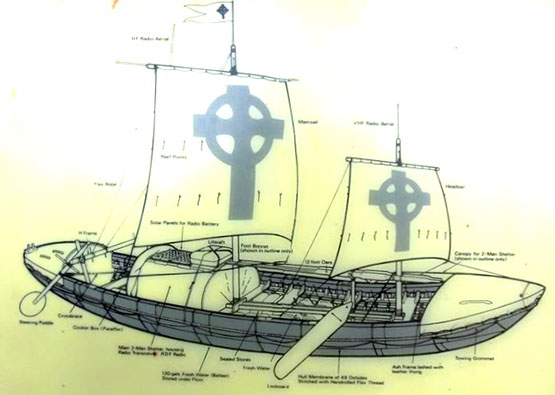
Details of Tim Severin’s oxhide “giant currach” with which – in 1976-77 - he showed that the supposedly mythical Transatlantic voyages of St Brendan the Navigator were technically possible. The St Brendan - which with Denis Doyle’s encouragement was built in Crosshaven Boatyard in 1975-76 – is now on permanent display at Craggaunowen in County Clare.
Then came the Vikings. Say what you like about the Vikings - and everybody has an opinion – but the reality is that their longships represented a quantum leap in naval architecture development. They brought state-of-the-art voyaging in versatile ships way ahead of anything seen before. Yet in time the Vikings were in their turn sucked into the Irish way of doing things, and far from turning Ireland into a seafaring nation, they seem to have literally burned their boats and set up home ashore, gradually absorbing the negative attitude towards the sea of their new neighbours, and taking on board the inevitable anti-seafaring attitudes of their new mothers-in-law
It wasn’t immediately as simple as that, of course. For a while, Ireland was the focal point of the Vikings’ sea trading routes along the coasts of western Europe, while Dublin had the doubtful distinction of being the biggest slave market in the constantly changing Viking western empire, which wasn’t really a territorial empire in the traditional sense, but was more a sphere of active influence and commercial and raiding activity. But it was undoubtedly a major centre which was totally dominated by all Viking activities, including ship-building, and the return to Dublin in 2006 of the 100ft Sea Stallion of Glendalough, a re-creation of one of the biggest Viking ships ever built (in Dublin in 1042), was a telling reminder of just how much Dublin had been to the fore in Viking life, while this video is a timely reminder of the great project completed in Roskilde ten years ago.
Inevitably, people of Viking descent were becoming a significant element in the Irish population, and even today we would naturally expect someone called Doyle to have something of the sea in their veins. Yet the Irish capacity for absorption of newcomers into the old ways of thinking has worked here too. The most common Irish surname today is Murphy. It means sea warrior. While those of us with maritime interests in mind would like to think it referred to an ancient tribe who went forth from Ireland to do successful battle on distant seas, we know in our heart of hearts that the Murphys are descended from warriors – mostly Vikings - who came in from the sea.
In time, they were enticed into domesticity by comely maidens who in due course became the formidable Irish mammies who prohibited any seafaring by their sons. Indeed, so far are most Murphys removed today from the sea that in some parts of the world the name is still a patronising nickname for the potato, something which is useful enough in its way, but its only maritime link is through fish and chips.
After the Vikings and then the Normans – who were really only Vikings with some slightly less rough French manners put on them – subsequent invasions were English-dominated, and the growth of British sea power was done in a manner which made sure that any Irish role in it was strictly of a subservient nature.

Rockfleet Castle in County Mayo, reputed deathplace of Grace O’Malley in June 1603. She was everything she shouldn’t have been, and in heroic style. She was Irish yet a mighty seafarer in command of her own ships, and a woman, yet a ruthless ruler of power and wealth who could combat men on equal terms.
Of course there were local heroes who tried to oppose this, the most renowned being Grace O’Malley, the Sea Queen of Connacht. But even when people of English descent tried to establish a separate Irish seafaring identity, as happened with the merchants of Drogheda, their aspirations would be slapped down by the dominant power and control from the government in London and the influence of the merchants of Bristol.
However, the government only had to look the other way for a moment before there was some local maritime enterprise was trying to flourish, and in the late 18th and early 19th Century the North Dublin smugglers, privateers and pirates of the little port of Rush in Fingal, people like Luke Ryan and James Mathews, were pace-setters in Europe and across the Atlantic, striking deals with Benjamin Franklin among others.
Depending on the state of international hostilities, sometimes their privateering trade could be quite open, and in Dublin the Freeman’s Journal of 23rd February 1779 reported that “we find the little fishing village of Rush has already fitted out four vessels, and one of them is now in Dublin at Rogerson’s Quay, ready to sail, being completely armed and manned, carrying 14 carriage guns and 60 of as brave hands as any in Europe”.
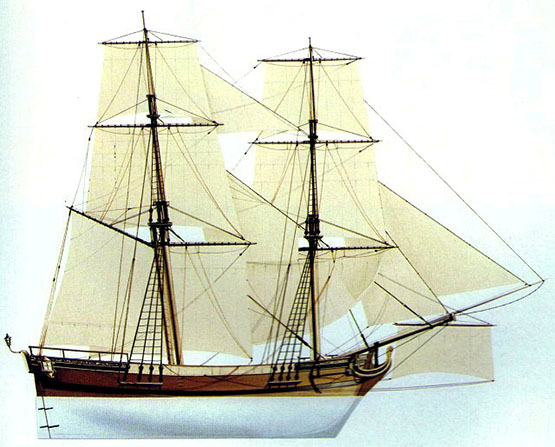
A late 19th century privateer, built for speed. When times were good for privateering, the little port of Rush in Fingal could provide a flotilla of these craft, which at other times could be kept hidden in the Rogerstown Estuary

The Admiral from Mayo. Being press-ganged by the Royal Navy was one of the many career-changing events which resulted in William Brown from Foxford becoming the founder-Admiral of the Argentine Navy.
But the majority of Irish seafarers were employed only in the humblest roles afloat, and often through the activities of the shore-raiding involuntary recruitment drives of the press gangs of Britain’s Royal Navy, However, this could produce some wonderful examples of unexpected consequences. The most complex was William Brown, of Foxford in Mayo, who had somehow risen to be a Captain in the American merchant marine when he was press-ganged into the Royal Navy, and after many vicissitudes, he ended up as a merchant in Buenos Aires. There, thanks to his unexpected acquisition of experience in naval warfare by courtesy of the Royal Navy, he became the founder of the Argentine Navy and an Admiral, as one does…..
Then there was the 18th Century Patrick Lynch of Galway, …….according to some stories, he was press-ganged. Be that as it may, the family made their fortune eventually in South America and a descendant, Patricio Lynch, owned the ship Heroina which played a significant role in Argentine history. The family continued to prosper in many directions, such that one decendant was Che Guevara, while another is the yacht designer German Frers, whose own pet yacht (which he gets little enough opportunity to use, as he is so busy designing boats for others) is called Heriona in honour of the family’s complex historic links through the sea with Ireland.
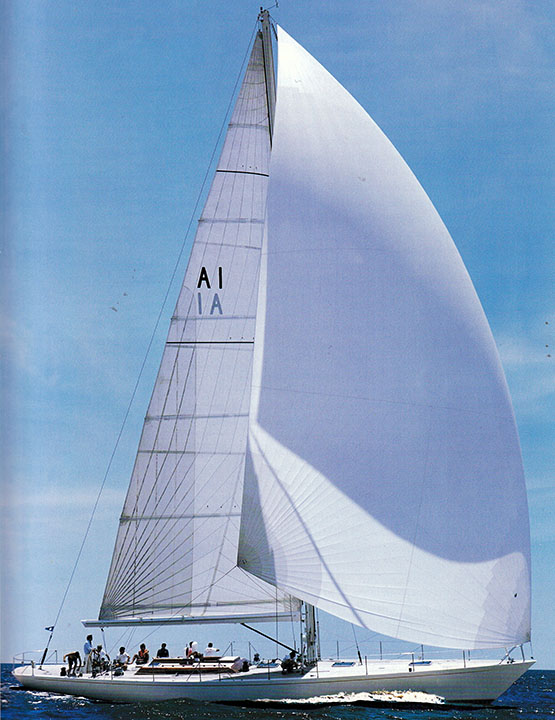
Yacht designer German Frers sailing his personal 74ft sloop Heroina in the River Plate. The boat is named in honour of the historic ship which belonged to his ancestor Patricio Lynch.
But while a very few of the young Irishmen press-ganged by the Royal Navy may ultimately have prospered in unexpected ways, the vast majority most definitely didn’t. Most came to a horrible end, while those who had managed to escape the press gangs’ clutches, together with the rest of the bulk of the native population, were reinforced in their inherited distrust of seafaring in any form.
Thus although we may now feel pride in the fact that the world’s first recreational sailing club was established with the Water Club of the Harbour of Cork in 1720, it’s difficult to avoid the conclusion that those great Munster landowners and merchants who founded it were partly doing it subconsciously just to show how very different they were from the ordinary run of Irish people in their attitude to the sea.
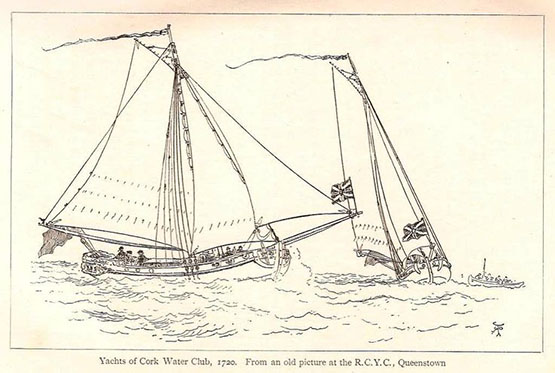
First instance of the “have nots” and the “have yachts”? The establishment of the Water Club of the Harbour of Cork in 1720 was a remarkable achievement, but if anything it emphasised the fact that the vast majority of Irish people had no enthusiasm or capability for the sea. Courtesy RCYC.
As for the official attitude when the Irish Free State finally came into being, its was so painfully sea-blind that we still need to draw a veil over its attitude, only noting that the first significant voyage under the new Irish ensign was made by one of that much-maligned class, a yachtsman. This was the great venture round the world south of the capes by Conor O’Brien of Limerick with his little Baltimore-built Saoirse between 1923 and 1925.
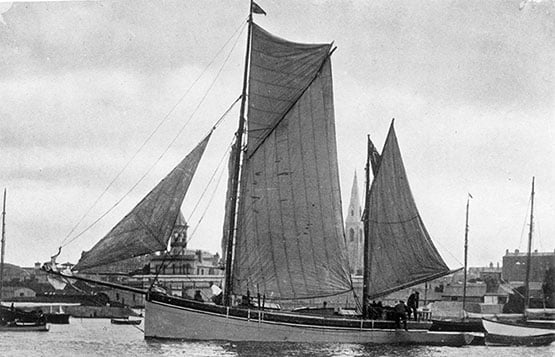
Conor O’Brien’s Saoirse departs Dun Laoghaire on her world- girding voyage on 20th June 1923.
O’Brien was to find Ireland so stultifying in its outlook after his return that he sailed away to live elsewhere, and we have to accept that for several decades the official approach reinforced the notion that being interested in the sea is un-Irish. So if we hope to change this attitude which still lingers today, a useful first step is to accept that for many of us, being non-maritime is the most natural thing in the world – we’ve had it instinctively from the very beginning, it’s in our handed-down and repeatedly-instilled inherited memories from the time when our most distant ancestors struggled ashore from battered little boats somewhere on the north coast, knowing that many others had died, and would die, trying to do the same thing.
Far from trying to pretend that this attitude doesn’t really exist, surely a much better way is to accept that it does, but that we’ve researched a perfectly valid explanation as to why this is so. Thus the way forward for Ireland to fulfill her maritime potential is to realize why this attitude is there in us, and take mature steps to offset it.
The fact is, in dealing with the sea, the Irish people have never had a level playing field. We’ve had to live with it and our inherited memories of being on it in very adverse circumstances. Unlike continental land dwellers, we have had no choice in the matter - we don’t see the sea as somewhere excitingly new with endless possibilities, we see it only with inherited distrust. And the determination of the current wave of walking migrants from the Middle East into Europe to attempt the sea crossing at only the narrowest part is further dreadful evidence of this.
But in another area of human endeavour, we’ve shown that we can do the business in competition with other nations. When aviation began to become part of everyday life a hundred years ago, it was unknown territory for all mankind. In terms of getting to grips with flying, it was a level playing field for all.
Yet here we are now in Ireland, an island in the Atlantic which is playing an extraordinarily active and central role in many aspects of aviation management and development, and certainly punching way above our weight. Looking at what we have been able to do in the air, it is surely time to look again at what we might do with the sea if we can look at it from a fresh perspective, and adapt the same can-do energies of the Irish aviation industry to the business of seafaring.
It’s time and more to shake off the old fears of the sea, while always maintaining a healthy respect for its undoubted power. That is best done by being in the vanguard of maritime technological development. And down around Cork Harbour, they’re doing that very thing. It’s just possible that, despite our ingrained anti-maritime attitude, we are beginning to view the sea in a more healthy and positive way. And it’s from our great southern port that we’re beginning to get inspiring leadership as the sea beckons us towards fresh opportunities.
So what, if nobody ever walked to Ireland? So what, if our distant ancestors had a very cold, very wet and very rough time getting here? It’s time to move on. Time to get over it. Time to start seeing the sea in a sensible way.

The little ship that carried the maritime hopes of a new nation. Conor O’Brien’s Saoirse in dry dock, showing the tough little hull that was able to register a good mileage most days in the Southern Ocean while still sailing in comfort. Yet when he returned to Dun Laoghaire in 1925 to complete his voyage with a rapturous homecoming reception, Conor O’Brien was soon to find that beneath the welcome there was increasing official indifference in the new Free State to Ireland’s maritime potential.
Clew Bay Island Owned By Late Beatle Up For Sale
#WaterfrontProperty - A private island in Clew Bay once owned by John Lennon could be yours for just €200,000.
Dorinish Island, among the most westerly of Clew Bay's islands – of which there's said to be one for every day of the year – was snapped up by the late former Beatle in 1967 as a retreat from his hectic rock'n'roll lifestyle.
But Lennon never actually built a holiday home on the island, and it was sold on to its current owners by Yoko Ono after her husband's death in 1980.
The last time Dorinish was actually inhabited was in the late 1800s, when marine pilots who guided ships into nearby Westport Harbour set up their homes there.
But that might change in the hands of the right owner and the requisite planning permission!
Sherry FitzGerald has more on this unique island property HERE.
#MaritimeFestivals - If you’re looking for a buzzing destination to spend the August bank holiday weekend, consider Clare Island in Co Mayo for the first Raft Building Championships, which promises seaside festival fun for all ages.
The organisers at Clare Island Adventures are challenging towns, villages, islands, companies and rival sports clubs to put together teams of four to six people to build a raft, then take one another around a 300-metre course in Clew Bay in what's expected to be a barrel of laughs for both spectators and participants alike.
Clare Island Adventures will provide all safety gear and raft-building materials. All you need to do is show up in a swimsuit with a can-do attitude and a determination to complete the course.
Prizes will be awarded to the top three places, as well as for the best dressed team – so the team theme is just as important as how you perform on the course!
Back on dry land, meanwhile, the music will be pumping and the barbecue will be smoking (weather permitting, of course).
Heats will take place on Sunday morning with the final taking place in the afternoon at approximately 4.30pm, allowing time for teams and spectators to get the ferry back to the mainland if they’re not staying on the island for the night.
To encourage you to make a weekend out of it, there’s an all-in deal on offer of two nights B&B in the hostel, return ferry and raft-building entry for €74 per person.
Families looking for entertainment for the whole weekend are also encouraged to come a day early with a family fun day taking place on the Blue Flag beach on Saturday afternoon. Kayaking, snorkelling and beach games will all be on offer.
Those planning to visit the island for the bank holiday, or any time in July or August, will also be interested to know that there is a new shuttle bus service operating between Westport and Roonagh five days a week.
The bus departs from Westport Adventure Hub on James Street, where tickets for bus and ferry can be purchased together. Buses leave Westport at 10.15am and Roonagh at 5.15pm.
For more information on the Raft Building Championships check out www.clareislandadventures.ie. To enter a team (the entry fee is €60 per team), contact 087 346 7713 or [email protected].
Mayo Mountain Rescue Breaks Record for Call-Outs on Croagh Patrick
#COASTGUARD - Mayo's mountain rescue unit has reported its busiest ever period with an "unprecedented" 14 call-outs in just six weeks, according to The Irish Times.
Irish Coast Guard personnel assisted Mayo Mountain Rescue on four of the total, helping to winch people who had fallen while descending Croagh Patrick on the south side of Clew Bay.
The injury toll on the mountain - accounting for 10 of the 14 recovery efforts - has prompted Mayo County Council to seek planning permission for a helicopter landing pad higher up the 2,500-foot peak.
The news comes just after Enniskillen RNLI was names the busiest lifeboat station in the island of Ireland, with 23 launches between its two inshore lifeboats and two rescue water craft over the summer months.
Live in Luxury On Your Own Island Off the West Coast
#WATERFRONT PROPERTY - Ever wanted to own your own island? With Inishturk Beg now on the market, now might be your chance - if you've got a few million to spend!
The 65-acre island property, lying in Clew Bay in Co Mayo, is home to one of Ireland's most luxury developments, comprising a six-bed main residence with five other houses, a pier and a floating marina, among many other features.
The main house - designed by award-winning architect Andrew Wright - is 12,000 sq ft over two floors, and comes with an adjacent leisure complex with a gym, games room, indoor pool and hot tub, a cinema and even a ceili hall.
Other residences on the island include the 1,600 sq ft Pavillion, the 700 sq ft Reef Cottage, the 600 sq ft Yard Cottage and the spacious 3-bed Pier Cottage. There is also a boat house, American-style barns and the island's original pier.
Also available under separate negotiation is Stud Cottage, located on the mainland by at Rosstoughy Harbour, an inlet of Clew Bay, sitting on 25 acres and with additional outbuildings.
Inishturk Beg provides the utmost in luxury and privacy in a sheltered position to the side of Clew Bay providing stunning vistas to match - and is located a mere 10km from Westport and less than 70km from Knock Airport.
The island is on the market for €2,850,000 by private treaty through Knight Frank. Contact Harriet Grant at 01 662 3255 to arrange a viewing, which is strictly by appointment only. Much more details on this property are available HERE.
Irish Private Islands Up For Sale
Three private islands off Ireland's west coast are now up for sale - with the cheapest being a snip at just €150,000.
Irish Central reports that the three islands are currently offered via the website privateislandonline.com which aims at the rich-and-famous market.
Mannions Island, in west Cork's Dunmanus Bay, is priced less than the average family home in Dublin. For €150,000 the buyer gets a four-acre island that's 60% fertile just 200m from the shore (the catch is that there are no buildings).
Further up the coast at Clew Bay in Co Mayo is Island Mor, a 70-acre gem with views of the Inish Gort lighthouse and Croagh Patrick, which is going for €902,000. The location is a popular one for celebs - John Lennon was once an owner in Clew Bay.
Last but not least is Mutton Island, a mile from Seafield Harbour in Co Clare and just 20 miles south of the Aran Islands. The largest of the three at 185 acres, it also has a storied history, with the first recorded human settlement in 548 AD. Price is available on request.





























